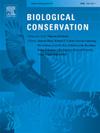探索景观连通性与城市生物多样性之间的关系:来自公民科学对法国巴黎传粉者和鸟类的见解
IF 4.4
1区 环境科学与生态学
Q1 BIODIVERSITY CONSERVATION
引用次数: 0
摘要
城市绿化已成为解决生物多样性丧失和促进可持续性的重要战略。加强城市景观连通性通常被认为是促进物种流动和支持生物多样性的必要条件。然而,经验验证仍然很少,特别是关于栖息地数量和连通性的相对作用。本研究利用市民科学数据,研究了景观连通性和植被数量对法国巴黎城市生物多样性的影响。利用公民科学数据,我们利用图论对生态网络进行建模,验证了三个假设:(H1)连通性增加与物种丰富度和丰度正相关,(H2)连通性-丰度关系取决于物种专业化,(H3)连通性影响鸟类群落组成,有利于高连接地区的专家。结果表明,功能连通性和植被覆盖度对传粉媒介和鸟类丰富度有正向影响。然而,鸟类的丰度主要受植被覆盖的影响,而不是连通性的总体影响。重要的是,功能连通性只有在考虑栖息地斑块大小时才具有显著的正向影响;否则,其影响将消失或变为负面影响。物种水平的分析显示,一些适应城市的鸟类对高连通性反应消极,表明碎片化可能有利于它们。这些发现强调了生物多样性对城市景观响应的复杂性,以及澄清连通性估计方法的必要性。该研究强调了在城市规划中整合栖息地数量和物种特异性生态学以优化绿色基础设施以促进生物多样性的重要性。本文章由计算机程序翻译,如有差异,请以英文原文为准。

Exploring the relationships between landscape connectivity and urban biodiversity: Insights from citizen science on pollinators and birds in Paris, France
Urban greening has emerged as a vital strategy to address biodiversity loss and promote sustainability. Enhancing landscape connectivity in cities is often cited as essential for facilitating species movement and supporting biodiversity. However, empirical validation remains scarce, particularly regarding the relative roles of habitat quantity and connectivity.
This study investigates the effects of landscape connectivity and vegetation amount on urban biodiversity in Paris, France, using citizen science data on passerine birds and pollinators. Using citizen science data, we modeled ecological networks with graph theory to test three hypotheses: (H1) increased connectivity positively correlates with species richness and abundance, (H2) the connectivity-abundance relationship depends on species specialization, and (H3) connectivity influences bird community composition, favoring specialists in highly connected areas.
Our results show that pollinator and bird richness is positively influenced by functional connectivity and vegetation cover. However, bird abundance is driven primarily by vegetation cover, with no overall effect of connectivity. Importantly, functional connectivity only has a significant positive effect when habitat patch size is considered; otherwise, its impact disappears or becomes negative. Species-level analyses revealed that some urban-adapted birds respond negatively to high connectivity, suggesting fragmentation may favor them.
These findings underline the complexity of biodiversity responses to urban landscapes and the need to clarify connectivity estimation methods. The study highlights the importance of integrating habitat amount and species-specific ecology in urban planning to optimize green infrastructure for biodiversity.
求助全文
通过发布文献求助,成功后即可免费获取论文全文。
去求助
来源期刊

Biological Conservation
环境科学-环境科学
CiteScore
10.20
自引率
3.40%
发文量
295
审稿时长
61 days
期刊介绍:
Biological Conservation is an international leading journal in the discipline of conservation biology. The journal publishes articles spanning a diverse range of fields that contribute to the biological, sociological, and economic dimensions of conservation and natural resource management. The primary aim of Biological Conservation is the publication of high-quality papers that advance the science and practice of conservation, or which demonstrate the application of conservation principles for natural resource management and policy. Therefore it will be of interest to a broad international readership.
 求助内容:
求助内容: 应助结果提醒方式:
应助结果提醒方式:


